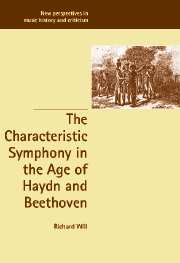Book contents
- Frontmatter
- Contents
- Acknowledgments
- Note to the reader
- Introduction
- 1 Paradise lost: Dittersdorf's Four Ages of the World and the crisis of Austrian enlightened despotism
- 2 Preaching without words: Reform Catholicism versus divine mystery in Haydn's Seven Last Words
- 3 The boundaries of the art: characteristic music in contemporary criticism and aesthetics
- 4 Paradise regained: time, morality, and humanity in Beethoven's Pastoral Symphony
- 5 Making memories: symphonies of war, death, and celebration
- Appendixes
- Bibliography
- Index
5 - Making memories: symphonies of war, death, and celebration
Published online by Cambridge University Press: 11 January 2010
- Frontmatter
- Contents
- Acknowledgments
- Note to the reader
- Introduction
- 1 Paradise lost: Dittersdorf's Four Ages of the World and the crisis of Austrian enlightened despotism
- 2 Preaching without words: Reform Catholicism versus divine mystery in Haydn's Seven Last Words
- 3 The boundaries of the art: characteristic music in contemporary criticism and aesthetics
- 4 Paradise regained: time, morality, and humanity in Beethoven's Pastoral Symphony
- 5 Making memories: symphonies of war, death, and celebration
- Appendixes
- Bibliography
- Index
Summary
The Eroica Symphony has a subtitle at once similar to the Pastoral's “memory of country life” and more immediate in its connotations: composta per festiggiare il souvenire di un grand Uomo (composed to celebrate the memory of a great man). More often than country life, great men were memorialized throughout the French Revolution and Napoleonic Wars in funerals, festivals, concerts, theater presentations, and art exhibits, which remembered their deeds and deaths and a great deal else besides, most notably the battles fought and the treaties signed by Europe's warring parties. Such occasions inspired works in all media, some seeking to reenact events and others aspiring to be, in Schiller's words, “Nicht unwert des erhabenen Moments / Der Zeit, in dem wir strebend uns bewegen” (not unworthy of the sublime moment in time in which we act and strive): a symphony like the Eroica, originally to have been entitled “Bonaparte,” or a historical play like Schiller's Wallenstein idealized the age and its actors while paintings or stagings of battles set down its history. Instrumental music pursued both aims, assuming roles previously reserved for opera and sacred vocal music as it marked battlefield victories and the deaths of rulers, or spoke to a culture of war in “military” symphonies.
- Type
- Chapter
- Information
- The Characteristic Symphony in the Age of Haydn and Beethoven , pp. 188 - 241Publisher: Cambridge University PressPrint publication year: 2002



